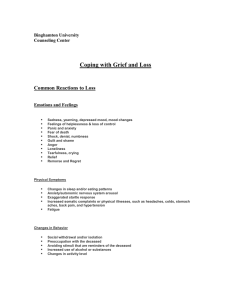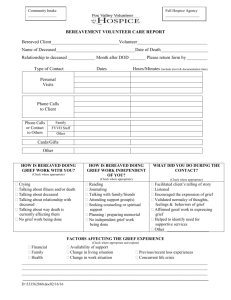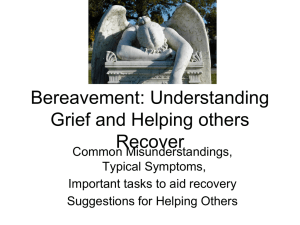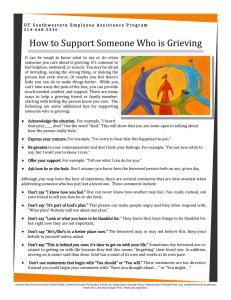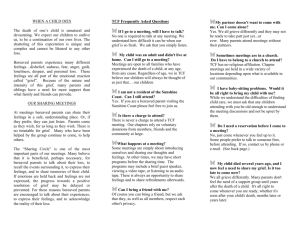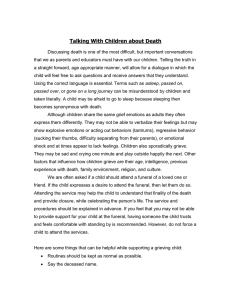Children often initially feel a sense of emotional shock when... may say or think “No, this didn’t happen. Daddy’s... HOW A GRIEVING CHILD THINKS, FEELS, AND MOURNS
advertisement
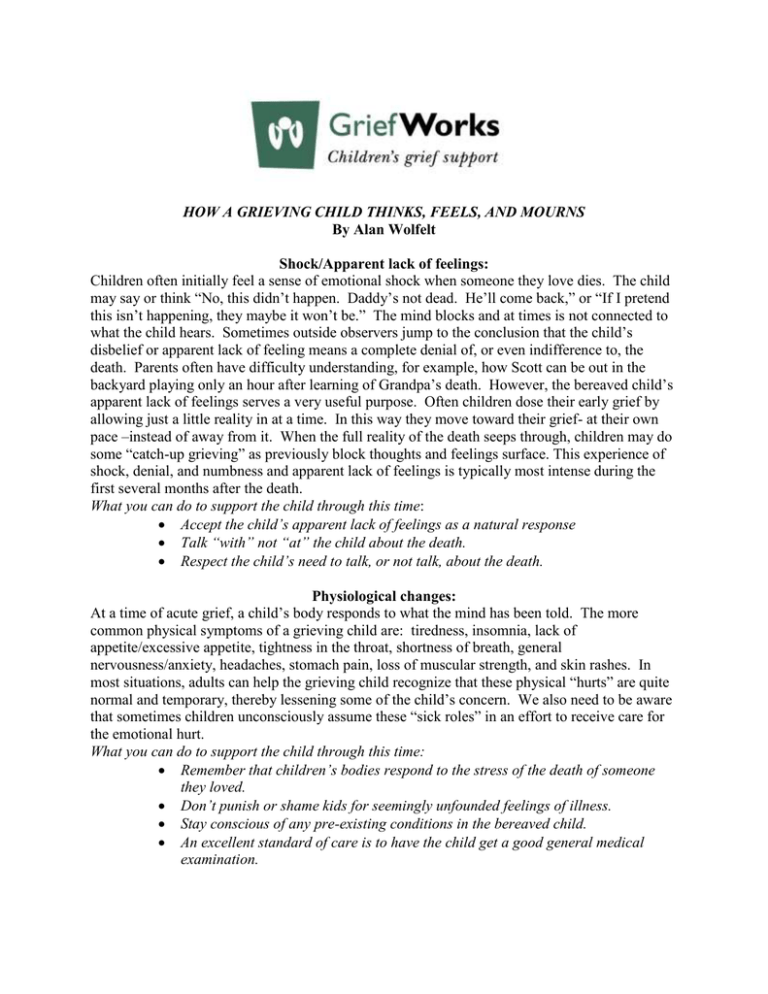
HOW A GRIEVING CHILD THINKS, FEELS, AND MOURNS By Alan Wolfelt Shock/Apparent lack of feelings: Children often initially feel a sense of emotional shock when someone they love dies. The child may say or think “No, this didn’t happen. Daddy’s not dead. He’ll come back,” or “If I pretend this isn’t happening, they maybe it won’t be.” The mind blocks and at times is not connected to what the child hears. Sometimes outside observers jump to the conclusion that the child’s disbelief or apparent lack of feeling means a complete denial of, or even indifference to, the death. Parents often have difficulty understanding, for example, how Scott can be out in the backyard playing only an hour after learning of Grandpa’s death. However, the bereaved child’s apparent lack of feelings serves a very useful purpose. Often children dose their early grief by allowing just a little reality in at a time. In this way they move toward their grief- at their own pace –instead of away from it. When the full reality of the death seeps through, children may do some “catch-up grieving” as previously block thoughts and feelings surface. This experience of shock, denial, and numbness and apparent lack of feelings is typically most intense during the first several months after the death. What you can do to support the child through this time: Accept the child’s apparent lack of feelings as a natural response Talk “with” not “at” the child about the death. Respect the child’s need to talk, or not talk, about the death. Physiological changes: At a time of acute grief, a child’s body responds to what the mind has been told. The more common physical symptoms of a grieving child are: tiredness, insomnia, lack of appetite/excessive appetite, tightness in the throat, shortness of breath, general nervousness/anxiety, headaches, stomach pain, loss of muscular strength, and skin rashes. In most situations, adults can help the grieving child recognize that these physical “hurts” are quite normal and temporary, thereby lessening some of the child’s concern. We also need to be aware that sometimes children unconsciously assume these “sick roles” in an effort to receive care for the emotional hurt. What you can do to support the child through this time: Remember that children’s bodies respond to the stress of the death of someone they loved. Don’t punish or shame kids for seemingly unfounded feelings of illness. Stay conscious of any pre-existing conditions in the bereaved child. An excellent standard of care is to have the child get a good general medical examination. You will sometimes see transient forms of identification with the person who died through physical illness (a child whose father died of cancer may complain of cancer “symptoms”). Regression When they’re under the stress of grief, children often want to return to the complete sense of protection and security they felt earlier in life. Among the more common regressive behaviors of childhood bereavement are the following: 1. Over-dependence on a parent to the point of declining to go outside to play as they have done in the past. 2. Desire to be nursed or rocked as they were at an earlier stage of development. 3. Desire to sleep with parent. 4. An unwillingness to separate from a parent for any length of time. 5. Desire to have others perform tasks for them that they are able to do for themselves, such as tying shoes, getting dressed, being fed and so forth. 6. Refusal to work independently in the school setting and/or demanding constant individual attention and demonstrating dependent behaviors to the teacher and peers. 7. Regression to talking baby talk and in general presenting themselves in an infantlike manner. 8. Breakdown in the ability to function adequately in peer relationships. Typically, regressive behaviors in bereaved children are temporary (although they sometimes last for months) and pass as the child receives support in the journey through grief. What you can do to support the child through this time: Allow the regressing bereaved child to retreat to this safer, less complex time; this behavior is natural after the death of someone loved. Remember that demonstrating regressive behavior may fill a significant need in the bereaved child’s life. Try to understand the unmet need underlying the behavior. Provide a trusting, supportive presence for the child. Disorganization and Panic A feeling bereaved children have that often occurs suddenly and unpredictably is a heightened sense of disorganization and panic. A wave of overwhelming thoughts and feelings makes the child wonder “Who is going to take care of me now? Will our family survive? Will I survive?” At times children may feel as if they are out of touch with the ordinary proceedings of life, and many children become frightened by the duration and intensity of their feelings. During this time, the child often confronts both good and bad memories from the past. For example, while the child receives comfort from remembering the sound of Mom’s voice, it is also painful. A child in this phase may dream of the person who died, appear restless and irritable, seem unable to concentrate, or experience a disruption in normal eating and sleeping patterns. The child may seem hypersensitive and cry over things that seem totally unrelated to the death. What you can do to support the child through this time: Remember that these thoughts and feelings of disorganization and panic may ebb and flow for months, even years after the death. During this time, the child may also have a real need to cry, talk or play out his grief. Remember that disorientation in grief proceeds reorientation. The thoughts, feelings, and behaviors of this dimension of grief do not come all at once and are often experienced in a wave-like fashion. Explosive Emotions A child’s explosive emotions – including not just anger but feelings of hate, blame, terror, resentment, rage and jealousy – can be upsetting and threatening to adults because they are often uncertain how to respond. Explosive emotions often express a child’s desire to restore things to the way they were before the death. They may also signal a bereaved child’s anger at the person who died because, as the child views the situation, “If Daddy loved me enough, he wouldn’t have died and left me.” The child may then further reason, “If Dad doesn’t love me, no one can love me. There must be something about me that makes me unlovable.” A bereaved child’s rage may be directed toward anyone available: a surviving parent, a teacher, playmates, God or the world in general. The fact that the dead person does not come back, despite the child’s explosive emotions, is actually a part of the reality testing necessary for eventual healing to occur. As the child gradually becomes aware that the person who died will not return, these explosive emotions will typically soften. Dr. Wolfelt states “There is a healthy survival value in being able to temporarily protest the painful reality of the loss. Having the capacity to express anger gives a child the courage to survive during a difficult time. Children who do not receive permission to do so may slide into chronic depression because they are literally deprived of a means of psychological survival. What you can do to support the child during this phase: Encourage the healthy expression of a child’s explosive emotions so these feelings will be expressed, not repressed. Remember that explosive emotional behavior often signals the child’s underlying feelings of pain, helplessness, frustration, fear and hurt. Provide alternate outlets for expression of anger. Acting-Out Many children express the pain of grief through acting-out. This behavior usually varies depending on the child’s age and developmental level. The child may become unusually loud and noisy, have a temper outburst, start fights with other children, defy authority, or simply rebel against everything. Other examples of acting-out behavior include getting poor grades in school or assuming a general attitude that says, “I don’t care about anything.” Understanding and appropriately responding to the bereaved child’s acting out may seem like a daunting task. But when broken down into its components parts, it is not so overwhelming. To begin, it is important to understand why bereaved children act out in the first place. A number of factors influence this behavior. Feelings of insecurity – Bereaved children naturally experience a sense of insecurity following the death of someone loved. After all, when it is a family member who has died, the child’s most stabilizing influence – the family – has been disturbed. Acted-out feelings unconcsciously provide the child with a sense of control and peace. While temper outbursts don’t resolve the child’s anxiety, they do provide a way for the child to feel he/she has regained some control. Tantrums and fighting also frighten others around the child, adding to the bereaved child’s feelings of power. Feelings of abandonment – Bereaved children may feel as if the parent they lost has abandoned or “died on them.” Consequently, they sometimes feel unloved; their selfesteem is affected. As a result, some bereaved children will act out to create a selffulfilling prophecy: “See, nobody loves me.” A desire to provoke punishment – Even though it is not rational to adults, some bereaved children reason that, “If I’m so bad that somebody I loved died, then I deserve to be punished.” Again, this reasoning is usually an unconscious process. When it is a parent who died – especially the parent who was the family’s primary disciplinarian – the child may act out in an attempt to get the parent to “come back” and mete out punishment. Protection from future losses – Bereaved children sometimes initiate rejection in an effort to prevent feelings of “abandonment” in the future. Their acting out behaviors serve to keep people at a distance. The result: They become the ones who control the situation rather than passively suffer the possibility of being left again. Essentially, the bereaved child unconsciously reasons that it is better to be the abandoner than the abandoned. Acting-out behavior protects the child from intimate relationships and the additional hurt and pain of a future loss. Demonstration of internal feelings of grief – As mentioned before, many bereaved children grieve but do not mourn. When this happens, feelings build up inside the child with no way to be expressed outwardly. Ultimately, the stress erupts – often in the form of acting-out behaviors. What you can do to support the child during this phase: Set limits without demonstrating anger or using violence. Recognize that adult discipline will eventually lead to self-discipline. Hypermaturity The opposite of regressive behavior on the part of the bereaved child is hypermaturity. This is when the child attempts to grow up very quickly and become the “man” or “woman” of the house, often in an effort to replace a dead parent. Bereaved children act overmature for a variety of reasons. It could be a symbolic way of keeping that parent alive. Or, it could be another way for her to protect herself from a common sense of hopelessness and helplessness. Regardless of the cause, hypermaturity is dangerous for bereaved children because it doesn’t allow them to deal with their grief at their own developmental levels. What you can do to support the child at this phase: Remember that children in single parent families often naturally mature more quickly due to the economic and social realities of this lifestyle. Keep in mind that well-meaning adults sometimes encourage this forced sense of maturity on a bereaved child because they find it easier to respond to the child at this inappropriate level. Be aware of the potential negative impact that trite comments can have on a bereaved child. Fear Grieving children often feel afraid. When the reality begins to set in that the parent or other significant person in the child’s life will not be coming back, it is not unusual for the child to become frightened. Frequently, the underlying fear is that there will be no one left to take care of them. This fear is increased when the child witnesses a surviving parent struggling with his/her own grief. Parents and other adults around the child must reassure her that she is loved and will be cared for. Another common fear is the fear of loving again. Children may reason that if they had not loved that person so much, they would not be experiencing the pain of this grief. Helping children understand and accept these feelings will help them cope. Children can be helped to understand that giving and receiving love are two of the greatest gifts of life. The presence of caring adults can make a true difference in a child’s ability to cope with many fears. Another common fear that many bereaved children experience is the fear of their own death. They may be frightened at the slightest hint of illness or secretly feel that they too will soon die. Again, the child needs reassurance and the loving support of adult caregivers. What you can do to help support a child during this phase: Adults must train themselves to be sensitive to a child’s fears. A sometimes helpful approach to exploring potential unspoken fears is to use the “wishes and fears” inventory with the child (ask the child to name 3 wishes and 3 fears). Another potentially useful tool to learn about fears is to do what I call “going fishing” (“fishing” for fears, asking/exploring that child’s fears) Guilt It is very human for both adults and children to blame themselves when someone they love dies. For children, this can be an especially tough struggle because they have particular difficulty understanding cause-effect relationships. Young children are susceptible to magical thinking; they believe that by thinking about something they can make it happen. What child, for example, hasn’t wished his/her parents would go away and leave him alone? So when a parent dies, the child may well assume blame and feel guilty for thinking these thoughts. The dimension of guilt may be revealed when the child says things like “If only I would have..” or “I wish I could have…” or “Why didn’t I…” Survival guilt and relief – Surviving a person who has died, particularly a parent, brother or sister, can generate feelings of guilt in children. The child may observe the other parent’s pain and reasons “Maybe it should have been me instead of my father.” What the child may not realize is that if she had died, the parent would be experiencing the same pain of grief. Relief-guilt syndrome – Another type of guilt may evolve when a person’s death brings a child some sense of relief or release. This situation often occurs when the person who died had been ill for a long time or the child’s relationship with the person who died was in conflict. For example, after a long illness, a child may not miss the frequent trips to the hospital or the family’s ongoing focus on the dying person. Personality factors and guilt – Another form of guilt evolves from long-standing personality factors within the bereaved child. Some children are taught early in life that when anything bad or unfortunate occurs, it is their fault. This kind of guilt becomes an ingrained part of their character development. Guilt and punishment – Some bereaved children anticipate that punishment (from outside or inside) should result from experiencing feelings of guilt. As a consequence, adults might see children attempting to lessen their guilt through punishment. They may directly or indirectly ask to be punished. Obviously, seeking out punishment is selfdestructive and only makes the child’s situation worse. For caring adults, the task is to help the bereaved child feel less guilty and thus reduce his need to demonstrate selfdestructive behaviors. Joy-guilt syndrome – A bereaved child can also experience feelings of guilt when she begins to re-experience any kind of joy or happiness in life. These feelings often stem from a sense of loyalty to the person who died and a fear that being happy in some way betrays that relationship. What you can do to support a child in this phase: Foremost, we must provide opportunities for the child to talk and play out the circumstance surrounding the death. In the case of the child who is too young to articulate thoughts and feelings, the sense of a trusting relationship with an adult figure is paramount. Go slowly in working through guilt with children. First, work to enter into what they think and feel in an effort to understand. Do be alert to some children’s conscious or unconscious need to punish themselves because of feelings of guilt. Sadness This dimension of grief is often the most difficult for bereaved children. The full sense of loss and emptiness never takes place all at once, and as it begins to set in, sadness, emptiness, and feelings of depression often follow. These feelings often surface when the child really realizes that the dead person will not be coming back. One difficulty with this sense of loss and emptiness is that it may take place long after adults in the child’s life think grief support is necessary – typically months following the death. As children struggle to come to terms with the finality and reality of the death, they very naturally become depressed. Of course, the death of a significant person in their life is something about which to be depressed. During this time the child may demonstrate: a lack of interest in self and others, change of appetite and sleeping patterns, prolonged withdrawal, nervousness, inability to experience pleasure, and low selfesteem. Obviously, the bereaved child is particularly vulnerable during this period. The child may actively seek a substitute for the person who died. Feelings of attachment can be displaced to the extent that a strong dependency upon another person occurs. The person to whom the child attaches often reminds the child of the person who died. What you can do to support the child during this phase: Encourage the child to talk about his intense feelings of sadness. Find creative ways for the child to express her sadness. Teach bereaved children about “griefbursts” so when they experience one, they’ll be less frightened (Griefbursts – sudden, unexpected and strong feelings of sadness). Reconciliation In many grief models, the final “stage” of bereavement is referred to as resolution. Other paradigms use the term recovery, re-establishment, or reorganization. The problem with these definitions is that people – children and adults alike – do not “get over” grief. Reconciliation is a term used by Dr. Wolfelt as it is more appropriate for what occurs while the bereaved person works to integrate the new reality of moving forward in life without that person. The bereaved child’s reconciliation after a death is a process, not an event. Among the changes often noticed during the child’s reconciliation process are: a return to stable eating and sleeping patterns, a renewed sense of energy and well-being, a subjective sense of release from the person who has died, increased thinking and judgment-making capabilities, the capacity to enjoy life experiences, a recognition of the reality and finality of the death, the establishment of new and healthy relationships. Perhaps the most important gain for the child in this reconciliation process is the discovery of the ability to cope successfully with the loss. This coping is achieved only with the assistance of caring adults. What you can do to support the child at this phase: If we are able to recognize that grief is a complex emotion that varies from child to child, we can be more open and honest in helping young people cope with death and achieve reconciliation. In a very real sense, grief is a privilege for both children and adults. Only because we have the capacity to love do we grieve. Adults must understand grief as an integral part of life and living and must work to reverse the trend toward protecting children from grief.
